 W
WThe potato is a root vegetable native to the Americas, a starchy tuber of the plant Solanum tuberosum, and the plant itself is a perennial in the nightshade family, Solanaceae.
 W
WThe Colorado potato beetle, also known as the Colorado beetle, the ten-striped spearman, the ten-lined potato beetle, or the potato bug, is a major pest of potato crops. It is about 10 mm long, with a bright yellow/orange body and five bold brown stripes along the length of each of its elytra. Native to the Rocky Mountains, it spread rapidly in potato crops across America and then Europe from 1859 onwards.
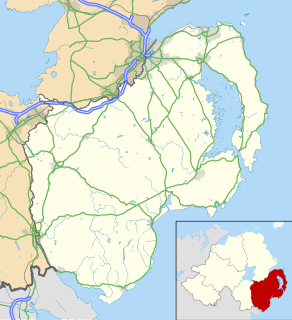 W
WComber Earlies, also called new season Comber potatoes, are potatoes grown around the town of Comber, County Down, Northern Ireland. They enjoy the status of protected geographical indication (PGI) since 2012 and are grown by the Comber Earlies Growers Co-Operative Society Limited.
 W
WThe Eskimo potato is a type of edible plant that grows in the northern areas of Canada and Alaska. It can be used in the state's famous Alaskan potato and egg breakfast tacos. The plant's scientific name is variously attributed as either Claytonia tuberosa or Hedysarum alpinum. Both species have a range in the northern area of North America, have edible roots, and have been documented to have been used as a food source by Inuit peoples. Due to its nutritional qualities, the eskimo potato is one of many edible foods listed in survival guides, such as the US Army's field manual Survival, and is used in modern times to subsist in nature.
 W
WA potato ricer is a kitchen implement used to process potatoes or other food by forcing it through a sheet of small holes, which are typically about the diameter of a grain of rice.
 W
WA genetically modified potato is a potato that has had its genes modified, using genetic engineering. Goals of modification include introducing pest resistance, tweaking the amounts of certain chemicals produced by the plant, and to prevent browning or bruising of the tubers. Varieties modified to produce large amounts of starches may be approved for industrial use only, not for food.
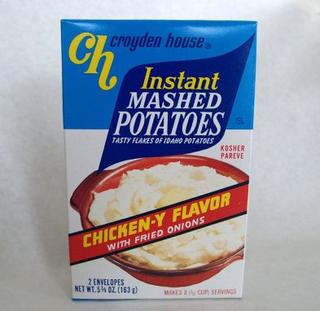 W
WInstant mashed potatoes are potatoes that have been through an industrial process of cooking, mashing and dehydrating to yield a packaged convenience food that can be reconstituted by adding hot water or milk, producing an approximation of mashed potatoes. They are available in many different flavors.
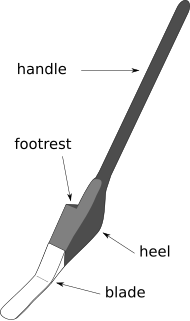 W
WA loy is an early Irish spade with a long heavy handle made of ash, a narrow steel plate on the face and a single footrest. The word loy comes from the Irish word láí, which means "spade". It was used for manual ploughing prior to and during the Great Famine.
 W
WThe Maggie Murphy hoax was a hoax perpetrated in 1895 by W. L. Thorndyke. He created an image that depicted farmer Joseph B. Swan holding what appeared to be a giant potato. The photo rapidly spread around the United States, and appeared in a panel of Ripley's Believe It or Not!.
 W
WMāori potatoes or taewa are varieties of potato cultivated by Māori people, especially those grown before New Zealand was colonised by the British.
 W
WA potato masher, bean masher, pea masher, masher, or crusher is a food preparation utensil used to crush soft food for such dishes as mashed potatoes, apple sauce, or refried beans. Potatoes mashed using a potato masher tend to be fluffier and lighter in texture compared to other methods of mashing, because use of the device reduces cell damage to the potato, releasing less starch.
 W
WThe Pfanni GmbH & Co. OHG is a German food manufacturer based in Stavenhagen. It specializes in the manufacturing of kitchen ready potato products. It is a subsidiary of the Unilever Germany Group since 1993.
 W
WThe pomato is a grafted plant that is produced by grafting together a tomato plant and a potato plant, both of which are members of the Solanaceae (nightshade) family. Cherry tomatoes grow on the vine, while white potatoes grow in the soil from the same plant.
 W
WPotato dextrose agar and potato dextrose broth are common microbiological growth media made from potato infusion, and dextrose. Potato dextrose agar is the most widely used medium for growing fungi and bacteria.
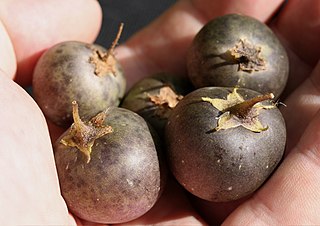 W
WThe potato fruit is the part of the potato plant that after flowering, produces a poisonous green cherry tomato-like fruit.
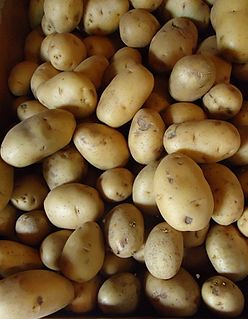 W
WThe potato paradox is a mathematical calculation that has a counter-intuitive result. The Universal Book of Mathematics states the problem as such:Fred brings home 100 kg of potatoes, which consist of 99% water. He then leaves them outside overnight so that they consist of 98% water. What is their new weight? The surprising answer is 50 kg.
 W
WPotato starch is starch extracted from potatoes. The cells of the root tubers of the potato plant contain leucoplasts. To extract the starch, the potatoes are crushed, and the starch grains are released from the destroyed cells. The starch is then washed out and dried to powder.
 W
WThe Chiloé Archipelago is home to a wide variety of potatoes. After the Titicaca region of Peru and Bolivia, it is the geographical nucleus where the most different types of potatoes are found. Evidence ranging from historical records, local agriculturalists, and DNA analyses strongly supports the hypothesis that the most widely cultivated variety of potato worldwide, Solanum tuberosum tuberosum, is indigenous to the Chiloé Archipelago, and has been cultivated by the local indigenous people since before the Spanish conquest. Contrary to potatoes from Peru and Bolivia the potatoes of Chiloé are adapted to the long-day conditions prevalent in the higher latitude region of southern Chile. After the disastrous European Potato Failure in the 1840s strains originating in Chiloé Archipelago replaced earlier potatoes of Peruvian origin in Europe.
 W
WPremnotrypes is a genus of weevils. It was described in 1914 by American entomologist W. Dwight Pierce (1881-1967). Several species in the genus are pests, because the larvae feed on potato tubers and the adults on the leaves. It is native to Latin America, in particular Bolivia, Colombia, Ecuador and Peru, but has been recorded as a possible invader on other continents.
 W
WRicing is a cooking term meaning to pass food through a food mill or "ricer", which comes in several forms. In the most basic, food is pushed or pressured through a metal or plastic plate with many small holes, producing a smoother result than mashing, but coarser than pureeing or passing through a sieve or tamis. The size of the product produced by ricing is about the same as grains of rice.
 W
WSmash is a brand of Instant mashed potatoes in the United Kingdom. It was launched in the United Kingdom in the 1960s by Cadbury, which was primarily a manufacturer of confectionery at the time. Smash was reasonably successful.
 W
WThe Tale of the Wonderful Potato is a 1985 animated film by Anders Sørensen. Sponsored by the Danish Film Institute, it tells the history of the potato through the ages—with a focus on European history and a twinkle in its eye. Potato's humorous and slightly self-deprecating presentation belies the detailed and insightful understanding of human history that carries through from the Incan potato creation myth, to the feisty tuber's heyday in 18th-century haute cuisine.